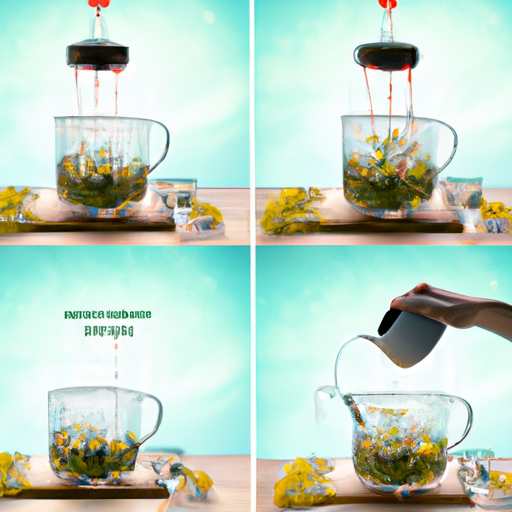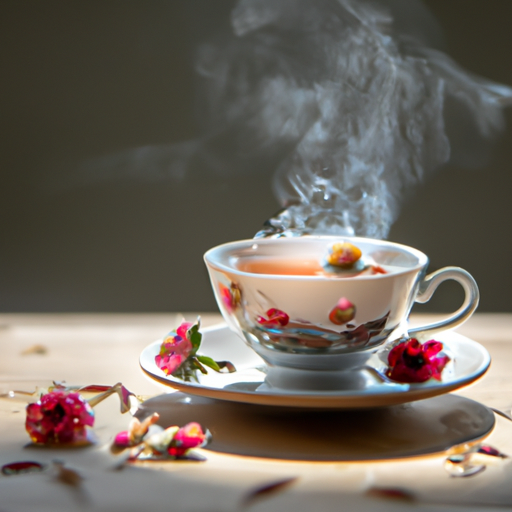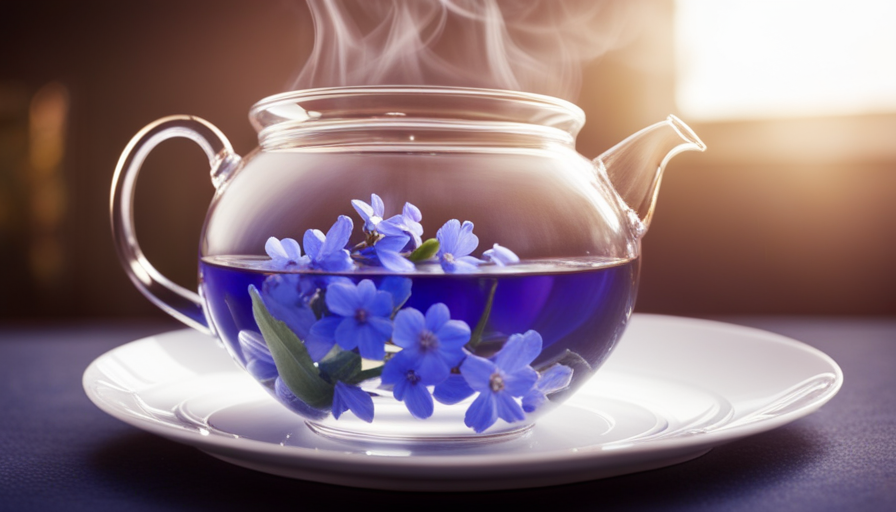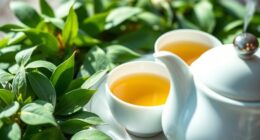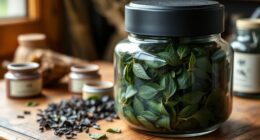If you want a delicious and revitalizing drink that will awaken your senses and nourish your body, you should consider trying fresh basil flower tea. This delightful herbal infusion, made from the delicate flowers of the basil plant, offers numerous health benefits that will make you feel refreshed and reenergized.
As a passionate tea enthusiast, I have discovered the art of creating this fragrant elixir, and I am excited to share my knowledge with you. In this article, I will guide you through the process of gathering fresh basil flowers, preparing the tea leaves, boiling the water, straining and sweetening the tea, and finally, serving and enjoying this divine concoction. Additionally, I will explore various variations and additions to enhance your basil flower tea experience.
So, let’s embark on this aromatic journey together and unlock the secrets of fresh basil flower tea.
Key Takeaways
- Choose healthy, fully bloomed basil flowers for making high-quality tea.
- Pluck fresh basil flowers and rinse them before steeping in boiling water.
- Infuse basil flowers in hot water for 5-7 minutes to release flavors and aromas.
- Strain the tea after infusing and sweeten it to taste.
Introduction to Basil Flower Tea
Making fresh basil flower tea is a delightful and aromatic way to enjoy the flavors and benefits of basil in a soothing and refreshing beverage.
Basil flowers, which bloom in beautiful clusters, can be used in a variety of ways, including as a key ingredient in traditional herbal teas. These flowers, with their vibrant colors and delicate petals, not only add visual appeal to your tea but also impart a subtle and unique flavor that complements the earthy taste of basil.
To make basil flower tea, simply pluck a few fresh flowers from your basil plant and rinse them gently under cool water to remove any dirt or debris. Then, bring a pot of water to a boil and add the flowers. Allow them to steep for about 5-7 minutes, or until the water takes on a light golden hue and the aroma of basil fills the air. Strain the tea into a cup, and it’s ready to be enjoyed.
Now, let’s move on to the health benefits of basil flower tea.
Health Benefits of Basil Flower Tea
Consuming basil flower tea can provide numerous health benefits, making it a delicious and beneficial addition to your daily routine. This herbal remedy is packed with antioxidants and nutrients that can support your overall well-being. Here are three ways in which basil flower tea can positively impact your health:
-
Boosts Immunity: Basil flowers are rich in vitamin C, which helps strengthen the immune system and protects against common illnesses. Regular consumption of basil flower tea can help ward off colds, flu, and other infections.
-
Improves Digestion: Basil flowers possess digestive properties that can aid in relieving indigestion, bloating, and constipation. The tea promotes the secretion of digestive enzymes, improving overall digestion and reducing discomfort.
-
Reduces Inflammation: Basil flower tea contains compounds with anti-inflammatory properties, such as eugenol and rosmarinic acid. These components can help reduce inflammation in the body and alleviate symptoms associated with conditions like arthritis and inflammatory bowel disease.
Incorporating basil flower tea into your daily routine can provide you with these health benefits and more. To fully enjoy its advantages, it’s essential to gather fresh basil flowers.
[Transition to the next section: "Gathering fresh basil flowers" can be done by mentioning the importance of using fresh flowers for making the tea.]Gathering Fresh Basil Flowers
To fully experience the benefits of basil flower tea, it’s crucial to gather the vibrant blossoms at the peak of their freshness. Harvesting techniques play a significant role in ensuring the quality of the tea leaves.
When gathering basil flowers, it’s important to choose plants that are healthy and free from any signs of disease or pests. Selecting flowers that are fully bloomed but not yet wilted is ideal. Gently pluck the flowers from the stems, being careful not to damage them.
Once you’ve gathered the basil flowers, it’s time to dry them. Drying is an essential step as it helps to preserve the flavor and aroma of the flowers. Lay the flowers in a single layer on a clean, dry surface, such as a drying rack or a baking sheet lined with parchment paper. Make sure to place them in a well-ventilated area away from direct sunlight. Allow the flowers to air dry for about two weeks or until they become brittle and crumble easily when touched.
With the basil flowers properly harvested and dried, they are now ready to be used in making the refreshing basil flower tea. Transitioning into the subsequent section about preparing the tea leaves, it’s important to note that using fresh and properly dried flowers will ensure a delightful and aromatic tea experience.
Preparing the Tea Leaves
Once you’ve got your dried basil flowers ready, it’s time to get the tea leaves prepared for a flavorful and aromatic experience. Harvesting basil is a crucial step in ensuring the quality of your tea. Choose a sunny day to gather the leaves when the plant is dry. This will prevent any moisture from affecting the drying process.
To harvest, gently pluck the leaves from the stem, making sure to remove any damaged or discolored ones.
Next, it’s important to dry the basil leaves properly. Lay the leaves in a single layer on a clean, dry surface, such as a baking sheet or a wire rack. Make sure to leave enough space between the leaves for air circulation. Avoid stacking or overcrowding them, as this can lead to mold or uneven drying. Place the leaves in a well-ventilated area away from direct sunlight. Allow them to air dry for about one to two weeks, or until the leaves become crisp and crumble easily.
Now that your basil leaves are dried and ready, it’s time to move on to boiling water for the tea.
Boiling Water for the Tea
Start by bringing water to a rapid boil, allowing the anticipation to build as the steam rises and fills the air with the promise of a comforting and invigorating cup of tea. Boiling water is a crucial step in preparing fresh basil flower tea, as it helps to extract the flavors and beneficial compounds from the basil flowers.
To ensure the best results, it’s important to follow a few tips and precautions. Firstly, use filtered or spring water for the tea to avoid any impurities that might affect the taste. Fill a kettle with enough water for your desired serving size, and place it on a stove over high heat. Keep a close eye on the water as it heats up, making sure it comes to a rolling boil. This ensures that the water reaches the optimal temperature for extracting the flavors of the basil flowers.
When boiling water, it’s important to handle it with caution. Use oven mitts or a towel to protect your hands from the hot kettle or pot. Additionally, avoid leaning over the boiling water to prevent any accidents or burns. Once the water has reached a rapid boil, carefully remove it from the heat source.
With the boiling water ready, we can now move on to the next step of infusing the basil flowers into the tea, adding a delightful aroma and taste to this refreshing beverage.
Infusing the Basil Flowers
After boiling the water, it’s time to move on to the next step in making fresh basil flower tea: infusing the basil flowers.
This is where the magic happens, as the flavors and aromas of the basil flowers are released into the hot water, creating a delightful and refreshing beverage.
To infuse the basil flowers, follow these three simple steps:
-
Gather a generous handful of fresh basil flowers. You can pick them from your own herb garden or buy them from a local farmer’s market.
-
Place the basil flowers in a tea infuser or a heatproof container. Make sure the flowers are fully immersed in the hot water to extract the maximum flavor.
-
Let the basil flowers steep in the hot water for about 5-7 minutes. This will allow the flavors to fully infuse into the tea, creating a robust and aromatic brew.
Now that the basil flowers have been properly infused, we can move on to the next step of straining and sweetening the tea.
But before that, let’s explore some other uses for basil flowers, such as using them in cocktails or drying them for culinary purposes.
Straining and Sweetening the Tea
Now it’s time for you to experience the sheer joy of filtering out those delightful basil flower remnants and adding a touch of sweetness to your invigorating infusion.
When it comes to straining your basil flower tea, you have a few alternative methods to choose from. One option is to use a fine mesh strainer or cheesecloth to remove any remaining flower particles. This will ensure a smooth and clear tea, free from any unwanted bits.
Another method is to use a tea infuser or tea bag, filling it with the basil flowers and allowing it to steep in hot water. This not only strains the tea but also makes it convenient for steeping and serving.
Once your tea is strained, it’s time to add a natural sweetener to enhance the flavor. There are several options to choose from, depending on your preference. Honey is a popular choice, as it adds a subtle sweetness that complements the herbal notes of the basil flowers. Alternatively, you can use maple syrup, agave nectar, or stevia for a different flavor profile. Simply add a small amount of your chosen sweetener and stir until it dissolves.
With your tea strained and sweetened, you’re now ready to move on to the next step of serving and enjoying your basil flower tea.
Serving and Enjoying Basil Flower Tea
To fully savor the aromatic infusion, you can elegantly present and relish the delightful flavors of this exquisite basil flower tea. Here are some serving techniques and flavor combinations to enhance your experience:
-
Serve the tea in delicate porcelain cups to appreciate the vibrant color and delicate aroma.
-
Pair the basil flower tea with light, fruity desserts like lemon bars or berry tarts to complement its herbal notes.
-
For a refreshing twist, add a splash of citrus juice, such as lemon or orange, to brighten the flavor profile.
-
Garnish each cup with a sprig of fresh basil to add visual appeal and a hint of additional fragrance.
-
To further enhance the flavors, serve the tea chilled on a hot summer day or warm during colder months.
Serving and enjoying basil flower tea is an art that combines aesthetics and taste. The presentation and combination of flavors can elevate the experience, allowing you to fully appreciate the unique qualities of this tea.
In the next section, we’ll explore the exciting variations and additions that can be made to basil flower tea to further tantalize your taste buds.
Variations and Additions to Basil Flower Tea
Let’s explore the exciting ways to jazz up your basil flower tea with different flavors and ingredients! Adding variations and additions to your tea can create unique and delightful taste experiences. One option is to experiment with flavor combinations by pairing basil flowers with other herbs and spices. For a refreshing twist, try adding a sprig of mint or a slice of lemon to your tea. If you prefer a bit of spice, consider adding a pinch of ginger or a few crushed cardamom pods.
Another way to enhance your basil flower tea is by incorporating herbal remedies. For example, you could add a few chamomile flowers for a calming effect or some lavender buds for a soothing aroma. These herbal additions not only add depth to the flavor profile but also offer potential health benefits.
To help you visualize the possibilities, here is a table showcasing some flavor combinations and their potential effects:
| Flavor Combination | Potential Effects |
|---|---|
| Basil + Mint | Refreshing and cooling |
| Basil + Lemon | Zesty and invigorating |
| Basil + Ginger | Warm and spicy |
| Basil + Chamomile | Calming and relaxing |
| Basil + Lavender | Soothing and aromatic |
By experimenting with these flavors and herbal remedies, you can create a customized basil flower tea that suits your taste preferences and desired effects. Now, let’s move on to the next section about storing and preserving basil flowers.
Storing and Preserving Basil Flowers
Discover the best way to keep your basil flowers fresh and vibrant for longer! Preserving basil flowers is essential to ensure that you can enjoy their unique flavor and fragrance for an extended period of time. Here are some effective techniques to store and preserve basil flowers:
-
Harvesting: Choose basil flowers that’re fully bloomed and vibrant in color. Cut the stems just above a leaf node to encourage further growth.
-
Drying: Hang the basil flowers upside down in a well-ventilated area away from direct sunlight. This method allows the flowers to air dry naturally and retain their flavor.
-
Freezing: Place the basil flowers in a single layer on a baking sheet and freeze ’em. Once frozen, transfer ’em to airtight containers or freezer bags. This method preserves the flowers’ freshness and allows you to use ’em in various dishes.
-
Infusing: Add fresh basil flowers to olive oil or vinegar to create infused oils or dressings. The flowers will infuse their flavors into the liquid, providing a delightful twist to your culinary creations.
-
Decorating: Arrange dried basil flowers in a vase or create potpourri to add a touch of natural beauty and fragrance to your living space.
By using these preserving techniques, you can enjoy the delightful flavors and creative uses of basil flowers all year round.
Frequently Asked Questions
Can I use dried basil flowers instead of fresh ones for the tea?
Yes, you can use dried basil flowers for making tea. However, it’s important to note that using fresh herbs in recipes offers several benefits. Fresh herbs have a more vibrant flavor and aroma compared to dried ones. They also contain higher levels of essential oils, which contribute to their medicinal properties. When using dried basil flowers for cooking, it’s advisable to use them sparingly as their flavor may be more concentrated.
How long do the health benefits of basil flower tea last?
The health benefits of basil flower tea can last for a significant period of time if stored properly. To extend the shelf life of basil flowers, it’s important to store them in a cool, dry place away from direct sunlight. This will help preserve their potency and nutritional properties.
Additionally, brewing basil flower tea with honey can enhance its benefits as honey’s known for its antibacterial and antioxidant properties, making it a perfect complement to the tea.
Can I use tap water instead of boiling water for the tea?
No, it’s not recommended to use tap water instead of boiling water for making basil flower tea. Boiling water is essential as it helps to extract the beneficial compounds from the basil flowers, such as antioxidants and essential oils. Tap water may contain impurities that can affect the taste and quality of the tea. Additionally, boiling water helps to kill any potential bacteria or pathogens that may be present in the flowers, ensuring a safe and healthy beverage.
What are some common variations and additions to basil flower tea?
Common variations of basil flower tea include adding lemon or honey for flavor, or infusing it with other herbs like mint or chamomile. These additions not only enhance the taste but also provide additional health benefits.
Basil flower tea is known for its antioxidant properties, which can help reduce inflammation and promote overall well-being. It also contains essential oils that have antimicrobial and antimutagenic effects.
Incorporating basil flower tea into your routine can be a delightful and healthful way to enjoy herbal infusions.
How long can I store and preserve basil flowers for future use?
The shelf life of basil flowers can be extended by using proper preserving methods. To preserve basil flowers for future use, it’s important to harvest them when they’re at their peak freshness. Remove any damaged or wilted flowers and wash them gently. After drying them thoroughly, store the basil flowers in an airtight container, preferably in the refrigerator.
Properly stored, basil flowers can last for up to a week, retaining their flavor and aroma.
Conclusion
In conclusion, making fresh basil flower tea is a delightful and health-promoting experience. The process of gathering the flowers and preparing the tea leaves allows for a connection with nature and the opportunity to enjoy the many benefits of this herbal beverage.
Did you know that basil flower tea contains high levels of antioxidants, which can help protect against oxidative stress and reduce the risk of chronic diseases? So next time you’re looking for a soothing and rejuvenating drink, give basil flower tea a try and reap the rewards of this natural remedy.



